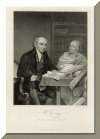
|
Hortus Bengalensis, OR A CATALOGUE OF THE PLANTS GROWING IN THE HONOURABLE EAST INDIA COMPANY'S BOTANIC GARDEN AT CALCUTTA
by William Roxburgh; edited by William Carey
Serampore: Printed at the Mission Press, 1814. |
Background Information
In 1814 at the Mission Press in Serampore, William Carey edited and published Dr. William Roxburgh's Hortus Bengalensis, or a Catalogue of the Plants Growing in the Honourable East India Company's Botanic Garden at Calcutta. Later in 1820 and 1824, Carey posthumously edited and published Roxburgh's Flora Indica; or Descriptions of Indian Plants.
Roxburgh (1751-1815) was an eminent botanist, horticulturalist, and physician.
From 1793 until his death, Roxburgh was the Superintendent of the Botanic
Garden in Calcutta, India.
Originally established in 1787 by the East
India Company, the Botanic Garden held significant interest for William Carey, and the
garden still exists today as the Indian
Botanic Garden.
Several plants and flowers are associated with Dr. William Roxburgh. At least one specimen
appears on the internet. Named Rosa
Roxburghii, this rose also is known as "Chestnut Rose," and was placed in the Botanic Garden, Calcutta, in 1824.
According to John Overton Choules, Christ's
Messengers; or, the Missionary Memorial (New York: E. Walker, 1845), p.
335, Roxburgh named the Saul tree Careya aborea.
A
prolific writer, Dr. Roxburgh corresponded with numerous persons in the Far East
and in Great Britain. To view a letter by Dr. Roxburgh, including page images of
his handwriting--click below for letters each man sent to Sir
Joseph Banks.
William Carey's Role in
Hortus Bengalensis
Carey's role in Hortus Bengalensis extended beyond the role of a contemporary editor. Carey contributed the twelve-page introduction, substantive comments, editorial notes, and botanical descriptions, appearing as a co-author by contemporary standards.
Hortus
Bengalensis contains two separate books. The
first part, including the
preface and twelve-page introduction by William Carey, runs through page 76. The
second part of the book--with a separate title page-- begins on page
77 and concludes on page 105. The Serampore Press published
both parts of the book.
Oddly, the first part appeared in 1814, but the second part is dated 1813. Whether this second part circulated separately before being combined into this single book with successive pages--i-xii and 1-105--is unknown. And, how much of the second part is directly from William Carey's hand is unknown.
Part I
|
HORTUS BENGALENSIS, OR A CATALOGUE OF THE PLANTS GROWING IN THE HONOURABLE EAST INDIA COMPANY'S BOTANIC GARDEN AT CALCUTTA Serampore Printed at the Mission Press, 1814. |
Part II
A Catalogue of Plants Described by Dr. Roxburgh, in His Mss. FLORA INDICA, But Not Yet Introduced into the Botanical Garden.
Serampore. 1813
|
| Page 77 (Title Page) | Page 82 | Page 83 | Page 104 | Page 105 |
William Carey's interests in botany and agriculture were expansive.
In 1820, he established the Agricultural and Horticultural Society of India. The
William Carey Bust
in the Agricultural Society of India memorializes Carey's contribution to the Society.
In addition, Carey's botanical interests are evident through his corresponding membership in the
Linnean Society of London, where some of his
archival papers reside.
One of the standard biographies of Carey, highlights his botanical interests: S. Pearce Carey,
William Carey, D.D., Fellow of the Linnaean Society (New York: George H. Doran Co., 1923).
To view a full color image of the background on this page, Bengale, Thé hyménée, click here; to view a larger image, click here. This image, Bengale, is a reproduction of an 1833 print painted by Pierre Joseph Redoute and appearing in his book, Beautiful Flowers and Fruits. Redoute (1759-1840), called the "Raphael of Flowers," was the one of the most popular of the French botanical artists.
Created: January 26, 2001 Updated: September 10, 2001